Cavitation of Multiscale Vortices in Circular Cylinder Wake at Re = 9500
Abstract
:1. Introduction
2. Methodology
2.1. Governing Equations
2.2. Cavitation Models
3. Mesh and Validation
4. Results and Discussions
4.1. Effects of Cavitation Models on Vortical Cavitations
4.2. Characteristics of Quasiperiodic Vortical Structures
4.3. Interactions of Vortical Evolution with Cavitation
5. Conclusions
Author Contributions
Funding
Institutional Review Board Statement
Informed Consent Statement
Data Availability Statement
Conflicts of Interest
References
- Peng, X.X.; Wang, B.L.; Li, H.Y.; Xu, L.H.; Song, M.T. Generation of abnormal acoustic noise: Singing of a cavitating tip vortex. Phys. Rev. Fluids 2017, 2, 053602. [Google Scholar] [CrossRef]
- Deng, Y.X.; Li, R.N.; Han, W.; Yang, W.J.; Li, Z.G.; Zhang, Y.P. Characteristics of backflow vortex cavitation in screw centrifugal pump. Trans. Chin. Soc. Agric. Eng. 2015, 31, 86–90. [Google Scholar] [CrossRef]
- Li, Y.X.; Zhou, D.Q.; Yu, A. Research of swirl cavity flow performance in the draft tube of pump turbine. Renew. Energy Resour. 2019, 37, 303–309. [Google Scholar]
- Eg, A.; Sj, B.; Mn, C.; Sb, C.; Cp, B.; Reb, A. Experimental and numerical study of cavitating flow around a surface mounted semi-circular cylinder. Int. J. Multiph. Flow 2020, 124, 103191. [Google Scholar] [CrossRef]
- Hu, Q.X.; Yang, Y.; Shi, W.D. Cavitation Simulation of Centrifugal Pump with Different Inlet Attack Angles. Int. J. Simul. Model. 2020, 19, 279–290. [Google Scholar] [CrossRef]
- Ebrahimi, A.; Razaghian, A.H.; Tootian, A.; Seif, M.S. An experimental investigation of hydrodynamic performance, cavitation, and noise of a normal skew B-series marine propeller in the cavitation tunnel. Ocean Eng. 2021, 238, 109739. [Google Scholar] [CrossRef]
- Köksal, Ç.S.; Usta, O.; Aktas, B.; Atlar, M.; Korkut, E. Numerical prediction of cavitation erosion to investigate the effect of wake on marine propellers. Ocean Eng. 2021, 239, 109820. [Google Scholar] [CrossRef]
- Stark, C.; Shi, W.C.; Troll, M. Cavitation funnel effect: Bio-inspired leading-edge tubercle application on ducted marine propeller blades. Appl. Ocean. Res. 2021, 116, 102864. [Google Scholar] [CrossRef]
- Tan, L.; Yu, Z.Y.; Xu, Y.; Liu, Y.B.; Cao, S.L. Role of blade rotational angle on energy performance and pressure fluctuation of a mixed-flow pump. Proc. Inst. Mech. Eng. Part A J. Power Energy 2017, 231, 227–238. [Google Scholar] [CrossRef]
- Tan, L.; Xie, Z.F.; Liu, Y.B.; Hao, Y.; Xu, Y. Influence of T-shape tip clearance on performance of a mixed-flow pump. Proc. Inst. Mech. Eng. Part A J. Power Energy 2018, 232, 386–396. [Google Scholar] [CrossRef]
- Fry, S.A. Investigating cavity/wake dynamics for a circular cylinder by measuring noise spectra. J. Fluid Mech. 1984, 142, 187–200. [Google Scholar] [CrossRef]
- Zhang, Y.N.; Qian, Z.D.; Ji, B.; Wu, Y.L. A review of microscopic interactions between cavitation bubbles and particles in silt-laden flow. Renew. Sustain. Energy Rev. 2016, 56, 303–318. [Google Scholar] [CrossRef]
- Berger, E.; Wille, R. Periodic Flow Phenomena. Annu. Rev. Fluid Mech. 1972, 4, 313–340. [Google Scholar] [CrossRef]
- Williamson, C.H.K. Vortext Dynamics in the Cylinder Wake. Annu. Rev. Fluid Mech. 1996, 28, 477–539. [Google Scholar] [CrossRef]
- Norberg, C. Fluctuating lift on a circular cylinder: Review and new measurements. J. Fluids Struct. 2003, 17, 57–96. [Google Scholar] [CrossRef]
- Desai, A.; Mittal, S.; Mittal, S. Experimental investigation of vortex shedding past a circular cylinder in the high subcritical regime. Phys. Fluids 2020, 32, 014105. [Google Scholar] [CrossRef]
- Kumar, P.; Chatterjee, D.; Bakshi, S. Experimental investigation of cavitating structures in the near wake of a cylinder. Int. J. Multiph. Flow 2017, 89, 207–217. [Google Scholar] [CrossRef]
- Gugulothu, K.; Rajesh, C.H.; Deekshith, P. Study of cavitation in the wake of a cylinder. In Proceedings of the IEEE-International Conference on Advances in Engineering, Science and Management (ICAESM-2012), Nagapattinam, Tamil Nadu, India, 14 June 2012. [Google Scholar]
- Dobroselsky, K.G. Applying PIV to study a fluid flow in the vicinity of a circular streamlined cylinder. J. Phys. Conf. Ser. 2019, 1421, 012015. [Google Scholar] [CrossRef]
- Pendar, M.R.; Esmaeilifar, E.; Roohi, E. LES Study of Unsteady Cavitation Characteristics of a 3-D Hydrofoil with Wavy Leading Edge. Int. J. Multiph. Flow 2020, 132, 103415. [Google Scholar] [CrossRef]
- Wang, Z.; Huang, B.; Zhang, M.; Wang, G.; Zhao, X.A. Experimental and numerical investigation of ventilated cavitating flow structures with special emphasis on vortex shedding dynamics. Int. J. Multiph. Flow 2017, 98, 79–95. [Google Scholar] [CrossRef]
- Asano, Y.; Watanabe, H.; Noguchi, H. Effects of cavitation on Kármán vortex behind circular-cylinder arrays: A molecular dynamics study. J. Chem. Phys. 2020, 152, 034501. [Google Scholar] [CrossRef] [Green Version]
- Gnanaskandan, A.; Mahesh, K. Numerical investigation of near-wake characteristics of cavitating flow over a circular cylinder. J. Fluid Mech. 2016, 790, 453–491. [Google Scholar] [CrossRef] [Green Version]
- Gnanaskandan, A.; Mahesh, K. A numerical method to simulate turbulent cavitating flows. Int. J. Multiph. Flow 2015, 70, 22–34. [Google Scholar] [CrossRef]
- Sauer, J.; Winkler, G.; Schnerr, G.H. Cavitation and Condensation-Common Aspects of Physical Modeling and Numerical Approach. Chem. Eng. Technol. 2000, 23, 663–666. [Google Scholar] [CrossRef]
- Zwart, P.; Gerber, A.G.; Belamri, T. A two-phase flow model for predicting cavitation dynamics. In Proceedings of the ICMF 2014 International Conference on Multiphase Flow, Yokohama, Japan, 30 May–3 June 2004; p. 152. [Google Scholar]
- Jiang, W.Q.; Zheng, Y.; Ge, X.F. Comparative numerical study of cavitation on a two-dimensional hydrofoil. S-N Water Transf. Water Sci. Technol. 2017, 15, 204–208. [Google Scholar] [CrossRef]
- Niu, X.D.; Chew, Y.T.; Shu, C. Simulation of flows around an impulsively started circular cylinder by Taylor series expansion- and least squares-based lattice Boltzmann method. J. Comput. Phys. 2003, 188, 176–193. [Google Scholar] [CrossRef]
- Liu, C.; Hu, C. An adaptive multi-moment FVM approach for incompressible flows. J. Comput. Phys. 2018, 359, 239–262. [Google Scholar] [CrossRef]
- Hejlesen, M.M.; Koumoutsakos, P.; Leonard, A.; Walther, J.H. Iterative Brinkman penalization for remeshed vortex methods. J. Comput. Phys. 2015, 280, 547–562. [Google Scholar] [CrossRef]
- Xiong, Y.; Guan, H.; Wu, C.J. LES Discretization Methods for Unstructured Meshes Based on the Finite Volume Method. Appl. Math. Mech. 2016, 37, 1129–1144. [Google Scholar] [CrossRef] [Green Version]
- Xiao, H.L.; Luo, J.S. Improvement of sub-grid model in large eddy simulation and applications in turbulent channel flow. J. Aerosp. Power 2007, 22, 583–587. [Google Scholar] [CrossRef]
- Gnanaskandan, A. Development of a Methodology for LES of Turbulent Cavitating Flows. Ph.D. Thesis, University of Minnesota, Minneapolis, MN, USA, 2015. [Google Scholar]
- Ji, B.; Cheng, H.Y.; Huang, B.; Luo, X.W.; Peng, X.X.; Long, X.P. Research progresses and prospects of unsteady hydrodynamics characteristics for cavitation. Adv. Mech. 2019, 49, 428–479. [Google Scholar] [CrossRef]
- Laberteaux, K.R.; Ceccio, S.L. Partial cavity flows. Part 2. Cavities forming on test objects with spanwise variation. J. Fluid Mech. 2001, 431, 43–63. [Google Scholar] [CrossRef]



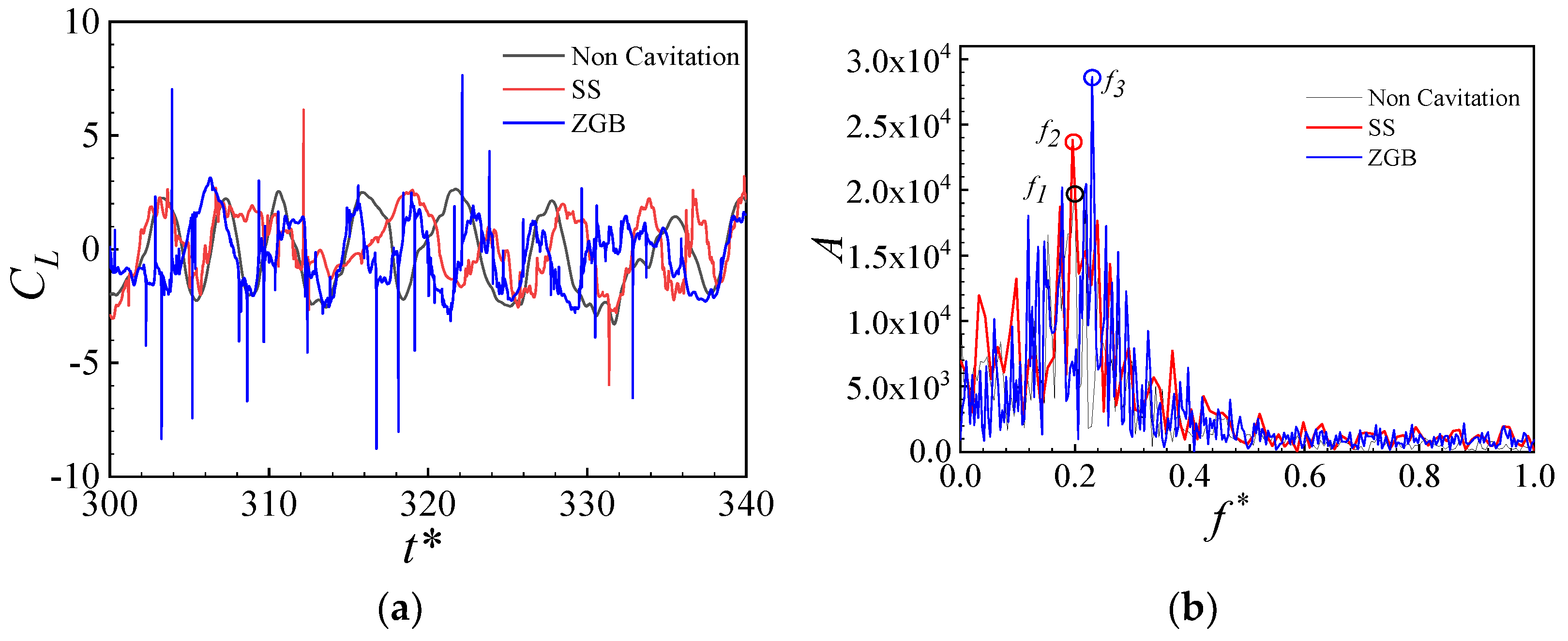
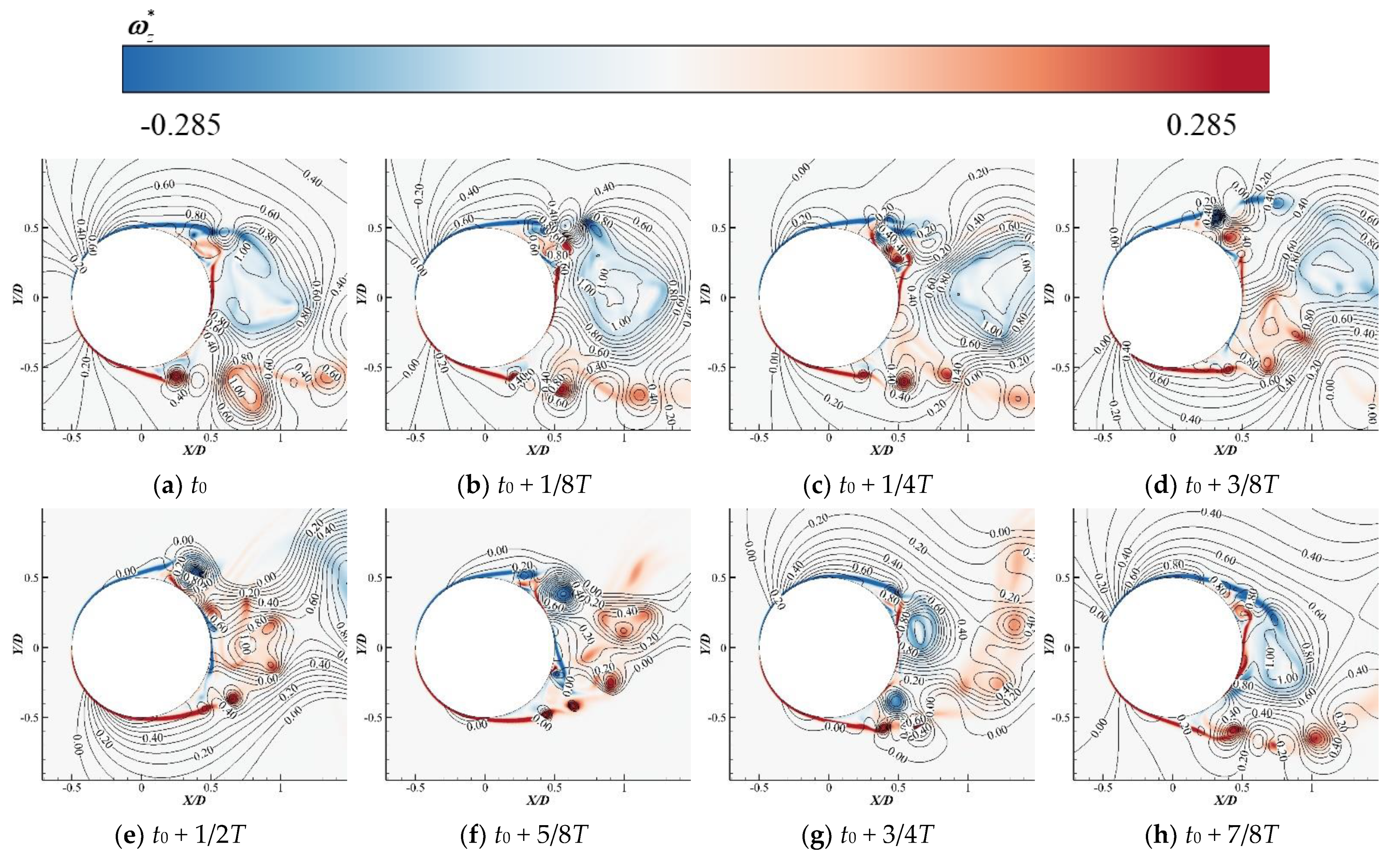
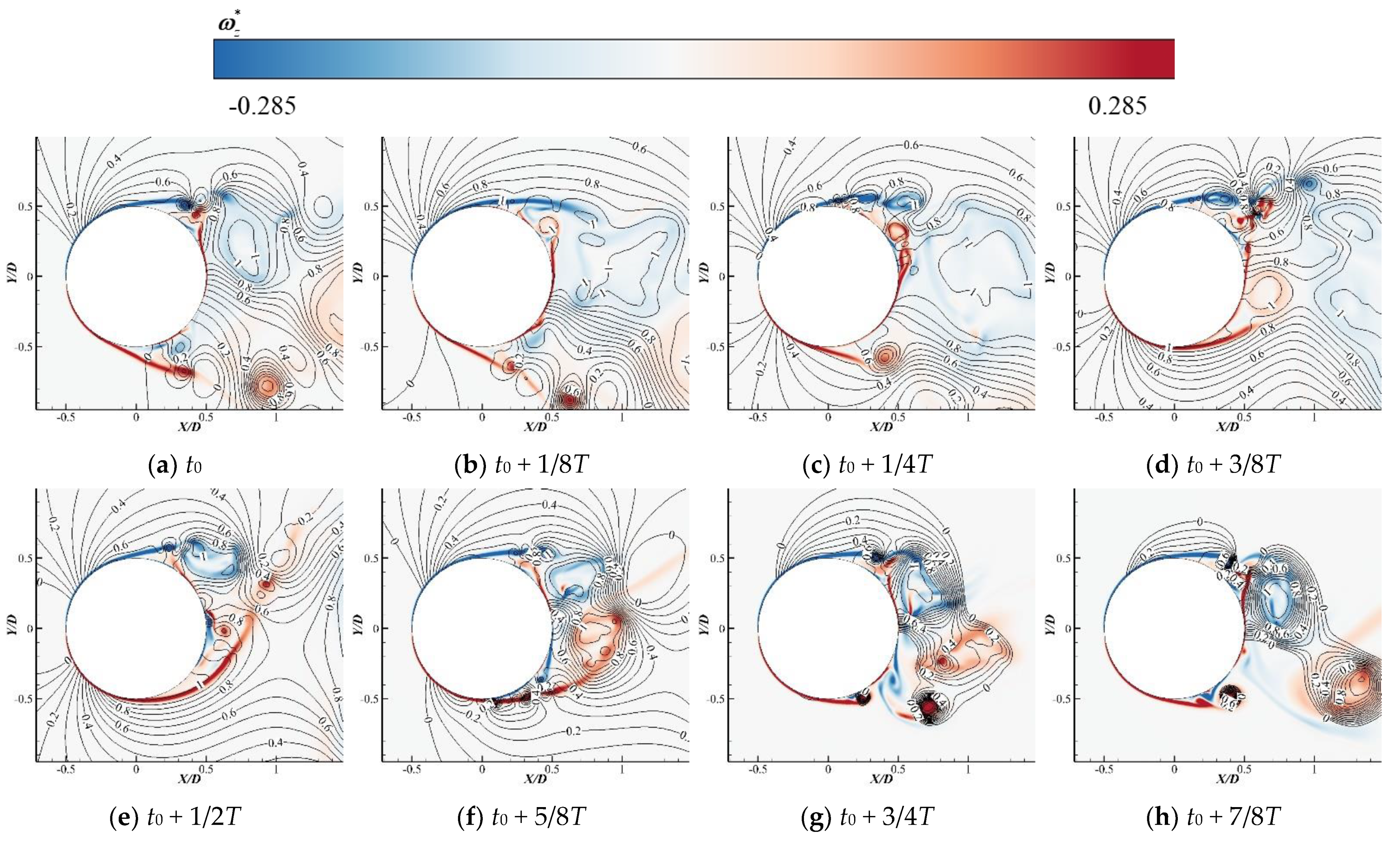
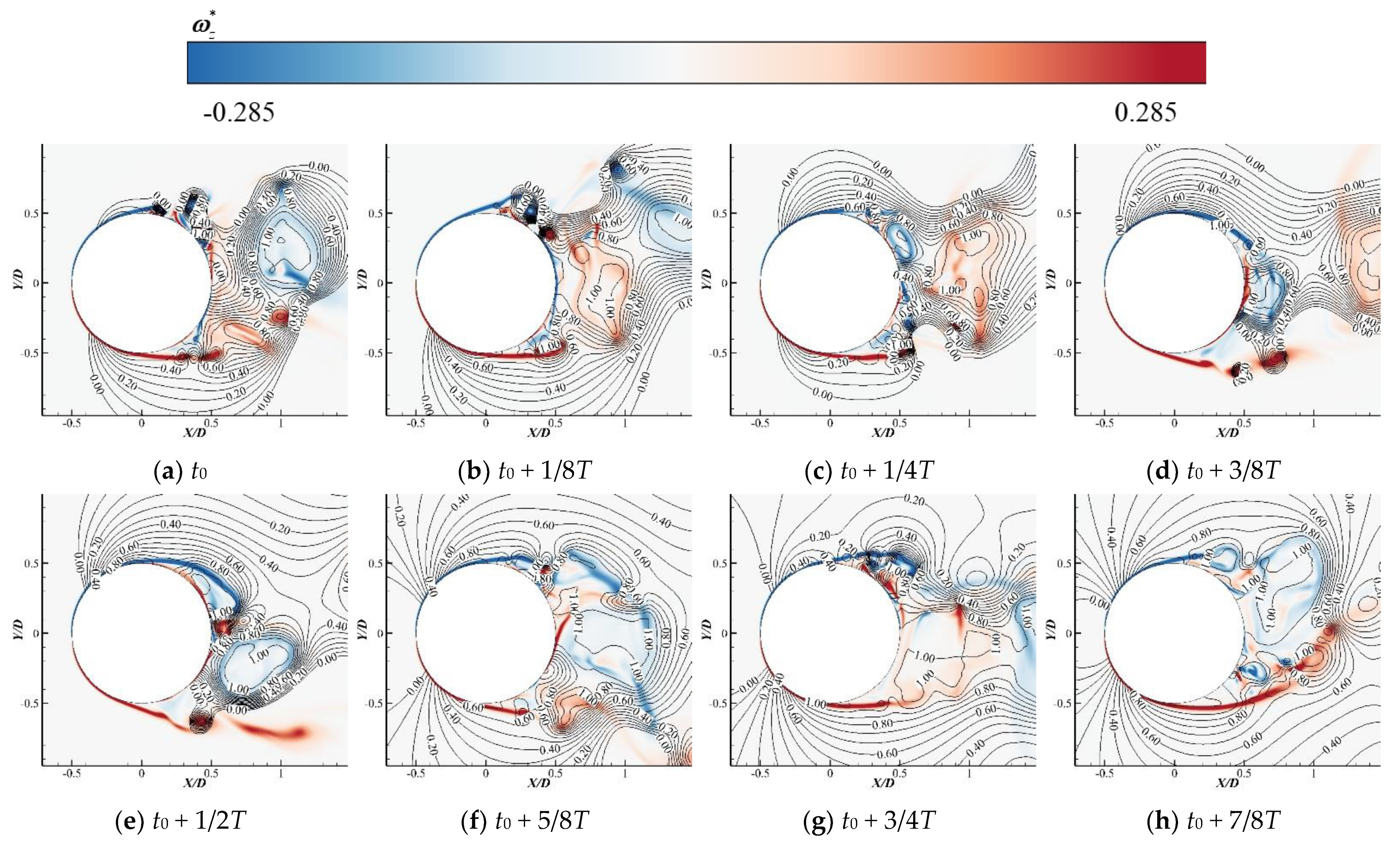


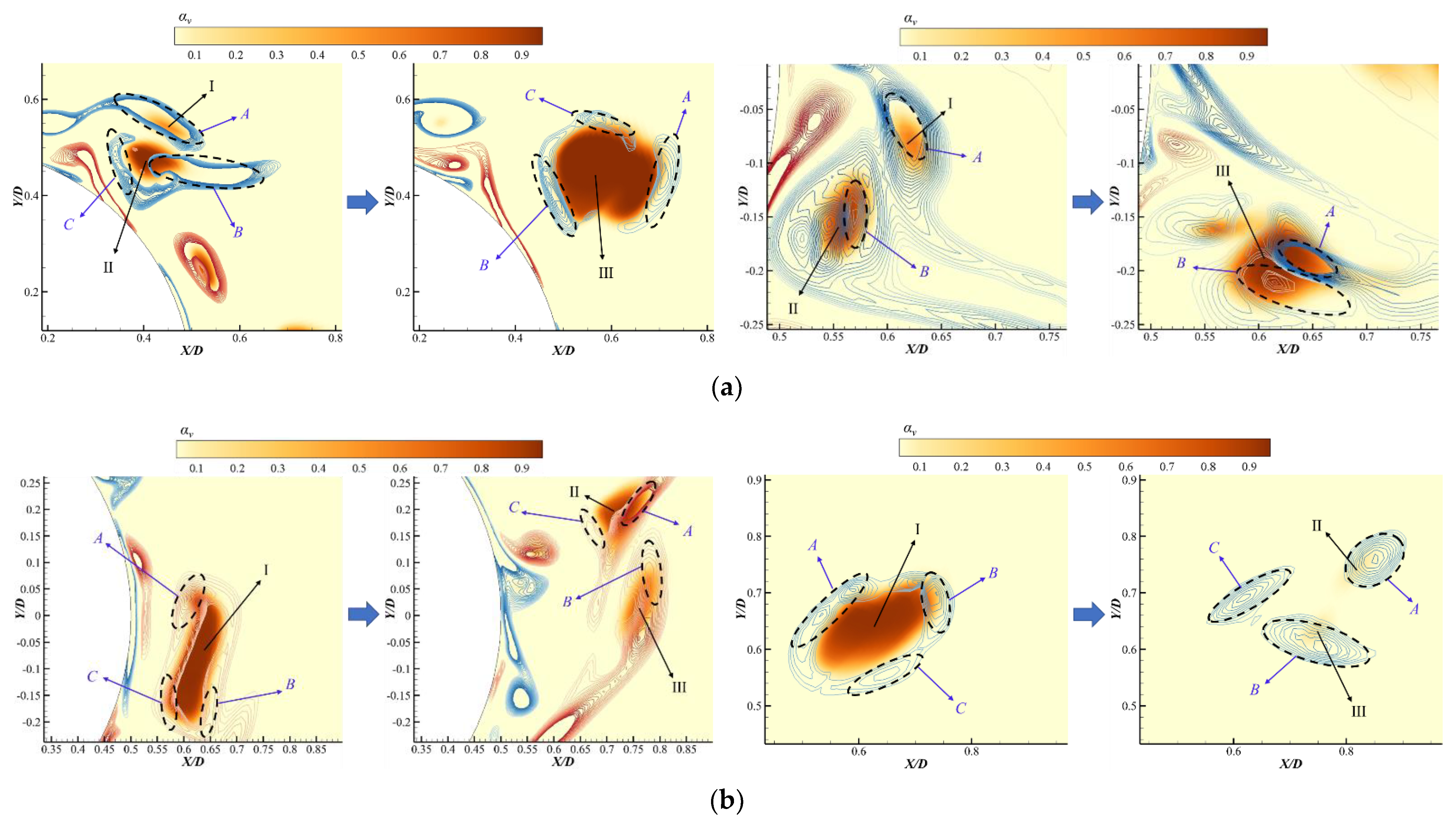
Publisher’s Note: MDPI stays neutral with regard to jurisdictional claims in published maps and institutional affiliations. |
© 2021 by the authors. Licensee MDPI, Basel, Switzerland. This article is an open access article distributed under the terms and conditions of the Creative Commons Attribution (CC BY) license (https://creativecommons.org/licenses/by/4.0/).
Share and Cite
Gu, F.; Huang, Y.; Zhang, D. Cavitation of Multiscale Vortices in Circular Cylinder Wake at Re = 9500. J. Mar. Sci. Eng. 2021, 9, 1366. https://doi.org/10.3390/jmse9121366
Gu F, Huang Y, Zhang D. Cavitation of Multiscale Vortices in Circular Cylinder Wake at Re = 9500. Journal of Marine Science and Engineering. 2021; 9(12):1366. https://doi.org/10.3390/jmse9121366
Chicago/Turabian StyleGu, Fadong, Yadong Huang, and Desheng Zhang. 2021. "Cavitation of Multiscale Vortices in Circular Cylinder Wake at Re = 9500" Journal of Marine Science and Engineering 9, no. 12: 1366. https://doi.org/10.3390/jmse9121366
APA StyleGu, F., Huang, Y., & Zhang, D. (2021). Cavitation of Multiscale Vortices in Circular Cylinder Wake at Re = 9500. Journal of Marine Science and Engineering, 9(12), 1366. https://doi.org/10.3390/jmse9121366






